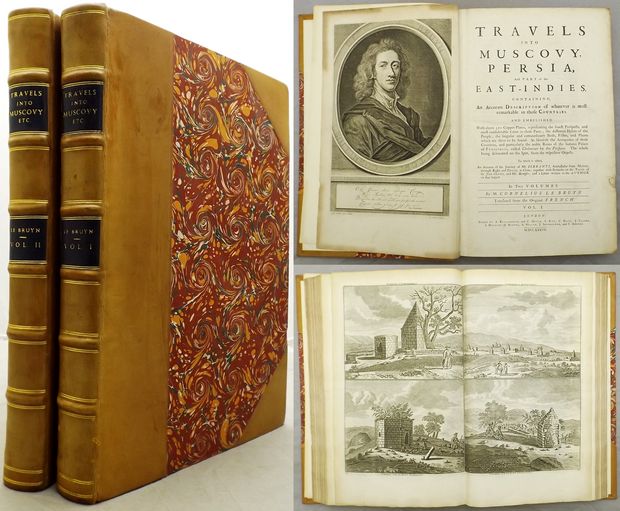TRAVELS INTO MUSCOVY, PERSIA,
And Part of the East-Indies. Containing, An Accurate Description of whatever is most remarkable in those Countries. And Embellished With above 320 copper plates, representing the finest Prospects, and most considerable Cities in those Parts; the different Habits of the People; the singular and extraordinary Birds, Fishes, and Plants which are there to be found: As likewise the Antiquities of those Countries, and particularly the noble Ruins of the famous Palace of Persepolis, called Chelminar by the Persians. The whole being delineated on the Spot, from the respective Objects. To which is added, An Account of the Journey of Mr Isbrants, Ambassador from Muscovy, through Russia and Tartary, to China; together with Remarks on the Travels of Sir John Chardin, and Mr Kempfer, and a Letter written to the Author on that Subject. Translated from the Original French. London: Printed for A. Bettesworth and C. Hitch ... 1737.1st English Ed. 2 vols. Sm. folio. [vi] + 228pp. + pp.(225-246). + [ii] + 223pp. + Index [xi] + [i] + [i] Directions to the Binder. Engraved port frontis. engraved by G. Valek after Kneller, allegorical frontis., 3 double page maps, 44 text engravings, 262 numbered engravings and 10 un-numbered engravings on l14 leaves of plates including 58 double page and 12 folding, dec. devices and initial letters. Marginal worming upto pp.2 of vol. 1. affecting the margins of maps, light browning, rebound in C20th half calf with marbled boards, some minor wear to joints with light cracking to firm upper joint of vol. 1. ESTC T110676. ‘English translation from a French translation of the original Dutch work ’Reizen over Moskovie, door Persie en Indie’ published in Amsterdam in 1711. Published in French with title ’Voyage de Corneille Le Brun par la Moscovie, en Perse, et aux Indes Orientales’ in Amsterdam in 1718. Vol.1 has an engraved illustrated frontispiece by Bernard Picart, dated 1711. The portrait of de Bruyn is by Godfrey Kneller. Pagination: Vol.1: [6], 228, 225-246 p., [60] leaves of plates (34 double leaves, 6 folded); v.2: [2], 223, [13] p., [59] leaves of plates (26 double, 7 folded). Vol.1: p.236-240 misnumbered 362, 263-266. Unnumbered pages: Vol.1: [6]p. comprise title page and preface. Vol.2: Title page; [13]p. at end comprise blank page, [11]p. index, and final blank page. Vol.1 contains [2], 3, 37, [10], 38-110 engravings (mostly numbered) on [60] leaves of plates. Vol.2 contains 111-262 numbered engravings on [59] leaves of plates. Text is continuous despite pagination and signatures. Text in double columns, with printed marginalia. With bibliographical references and index.’ Cornelis de Bruijn (also spelled Cornelius de Bruyn, pronounced [d’ 'brœy’n]; 1652 – 1726/7) Dutch artist and traveler. He made two large tours and published illustrated books with his observations of people, buildings, plants and animals. ‘... De Bruin’s travel account does not provide major new insights into Persian society, life, and customs, but it is a straightforward, thorough, and balanced account, without the elements of fantasy that mar most other works by contemporary travelers to Persia, particularly in their discussions of Persepolis ...’ Bibliotheca Irania. In 1701 he headed for Archangelsk. During his second tour he visited the Samoyeds in northern Russia. In Moscow he became acquainted with emperor Peter the Great painting his nieces, the paintings being sent to possible candidates for marriage. In late April 1703, De Brujin left Moscow along with the party of Armenian merchants from Isfahan, together they sailed down the Moscow River, the Oka and the Volga, eventually reaching Astrakhan. Thanks to his short stopover in Nizhny Novgorod during the Easter holidays, we now have his description of that major center of the Russian Volga trade as it existed in 1703, with its Kremlin, stone churches, and a lively bar (kabak) scene. Leaving the borders of the Russian state, de Brujin arrived to Persia, where he made drawings of towns like Isfahan and Persepolis (1704–1705). He continued to Java and returned to Persia, Russia, and ultimately the Netherlands. His drawings of Persepolis, caused a sensation, for a century, they were the best prints available to western scholars.
£3,600.00 [ref: 252823] enquire

